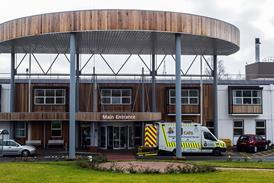A patient-centred service is a distant vision from Danny Boyle’s Olympic celebration
Isle of wonder, or killing fields?
After the hagiography of the Olympics opening ceremony, this week exposed the shocking reality within the NHS.
Any staff member who criticises the quality of their organisation’s healthcare is fired. This seems the automatic response of any management, regardless of the fact that patients’ safety or lives are being put at risk. The government has been tardy in enforcing whistleblowing legislation.
At the same time, the medical establishment continues to acquiesce in the “killing fields”, with all newly qualified doctors being thrown in at the deep end every year on the same day without proper supervision, resulting in unnecessary deaths. A patient-centred service remains a distant vision.
Roger M Goss, co-director, Patient Concern
Patients are people, not cost centres
When Danny Boyle championed the NHS as one of the finest British success stories of all time, he saluted an institution that delivers the same promise today that it made in 1948. But that does not mean it shouldn’t be adapted to respond to changing needs. Professor Terence Stephenson, chair of the Academy of Medical Royal Colleges, was perfectly within his rights to call for major NHS rationalisation, even if some hospitals are made centres of excellence while others are downgraded.
If clinical commissioners are to make 20 per cent efficiency savings of the NHS’s costs over five years, while retaining the quality of care for which it is famous, changes must not be limited to acute medicine. We must also adapt to changing demands, and especially those of an ageing population.
Our surgeries are not day centres and our hospitals are not quasi care homes. We have a duty to keep our patients out of both.
The government gets it. The “whole system demonstrator” clinical study and resultant Three Million Lives campaign wants to see care delivered at home, and not in the hospital, through a greater deployment of telecare and telehealth within the next five years.
The BMJ gets it, too. At least in part. It considered the use of secondary care and patient mortality among 1,600 telehealth patients and found that just over half as many patients receiving telehealth died as in the control group. What a shame the BMJ seems more exercised by savings in hospital costs it considers to be modest than in the enormous benefits in care that have been demonstrated. I suggest overall cost savings may not appear significant because living patients continue to need healthcare.
The BMJ also went wrong in ignoring activity “not covered by PBR tariffs such as mental health, critical care, cystic fibrosis, high cost drugs and outpatient physiotherapy” - conditions of enormous importance to patients who will sleep better in the knowledge that their conditions are being monitored 24/7 by people concerned about their welfare.
Telehealth reduces hospital admissions while reducing the death rate. It irons out the inequalities in healthcare received by the long-term sick, and especially the elderly, while helping to control their ever growing cost.
I want clinical commissioning to really change the NHS and we can start by thinking about patients as individual people, and not as cost centres.
Simon Fradd, GP in London, clinical lead for Southwark Clinical Commissioning Group, and an advisor to Tunstall Healthcare Group.
Standard bearer
It was great to read Alison Moore’s coverage of the recent breakfast summit hosted by NHS Employers, which focused on creating the right conditions to enable staff to “speak up” to prevent harm to patients. However it was disappointing to read that some of the points made were misguided.
We have a long way to go to fully embrace the scientific discipline of human factors (ergonomics) to enhance the efficiency and productivity of the NHS and to keep patients safe, so it is vital that misunderstandings are corrected along that journey.
Counter to the report, standardisation is not widely appreciated or it would be better applied in the NHS. The recent call by the Royal College of Nursing and the Royal College of Physicians for a standard observation chart to assist staff in identifying deteriorating patients is one an excellent example of how we can standardise to work smarter and safer in the NHS.
Ask a junior doctor or a newly qualified nurse about how and where the NHS could and should standardise, they are not short of ideas, we should listen to them.
Professor Jane Reid, on behalf of the Clinical Human Factors Group
Fertile ground
I read with interest your recent article “How to avoid stretch marks on your budget”. The author does indeed highlight a significant problem: more couples want IVF, NICE seems to agree that they should get it, and yet it represents a significant and growing portion of NHS expenditure.
The author does not, however, shed any light on some of the alternatives to IVF that are growing in popularity - perhaps because these are frequently sidestepping NHS expenditure altogether. For example, a spin-out from Cambridge University has developed a telemedicine solution for infertility that is suitable for about one third of all IVF patients, and (according to an early published study) provides a similar pregnancy rate at a tenth of the cost. As is likely to be common in the future of healthcare technology, DuoFertility became available direct-to-consumer through the pharmacy chain Boots more than 18 months before the first NHS trials of the technology started.
To answer the implicit question that the author raises in the title, the fostering and early adoption of innovative technologies way well be the way to avoid stretch marks on your budget.
Dr Shamus Husheer, DuoFertility
























No comments yet